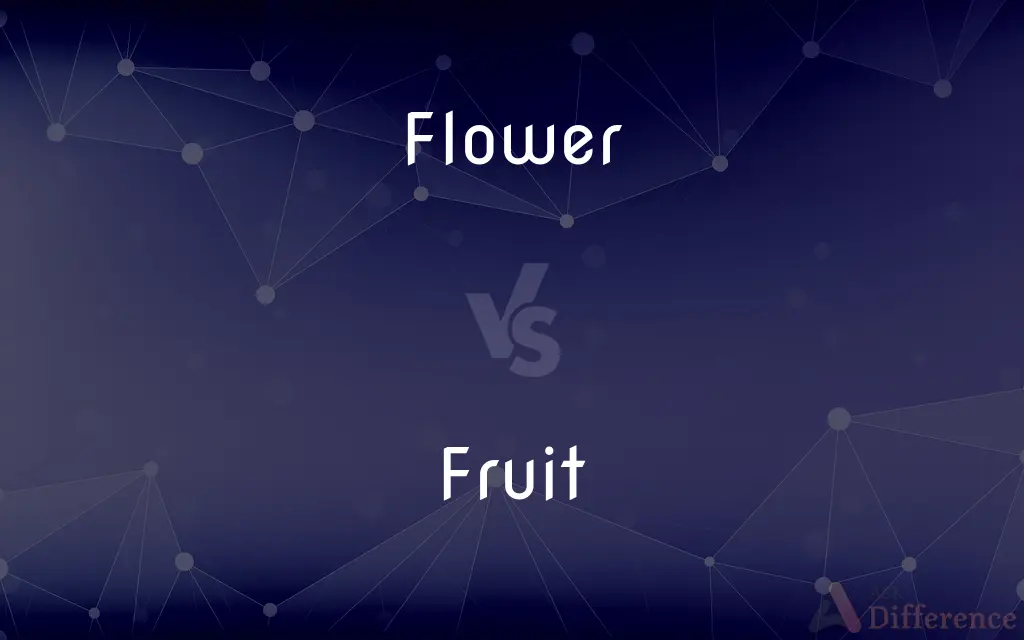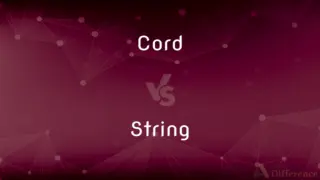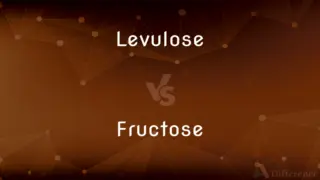Flower vs. Fruit — What's the Difference?
By Tayyaba Rehman & Fiza Rafique — Updated on March 8, 2024
Flowers are the reproductive structures of flowering plants, involved in seed production, while fruits are the mature ovaries of flowers, containing seeds and aiding in their dispersal.

Difference Between Flower and Fruit
Table of Contents
ADVERTISEMENT
Key Differences
Flowers serve as the reproductive organs of flowering plants (angiosperms), designed to facilitate pollination—the transfer of pollen from the male stamens to the female pistil. This process can result in fertilization, leading to the development of seeds. Flowers can vary greatly in appearance, color, and scent, adaptations which often aim to attract pollinators such as insects or birds. On the other hand, fruits develop from the fertilized ovary of a flower after pollination. Their primary role is to protect the seeds during development and to aid in their dispersal, whether through wind, water, or animals. Fruits can be fleshy or dry and are classified based on their structure and the way they develop.
While the presence of a flower is crucial for the production of fruit, not all flowers result in fruit. Some flowers may be sterile, or conditions may not be favorable for pollination or fertilization to occur. Additionally, the distinction between flowers and fruits is evident in their roles: flowers are involved in the creation of new seeds, while fruits are involved in the protection and distribution of those seeds.
In terms of human use, both flowers and fruits have significant roles. Flowers are often valued for their aesthetic appeal and are used in decorations, ceremonies, and as symbols in various cultural contexts. Fruits, besides their role in plant reproduction, are a vital source of food, vitamins, and minerals for humans and many animals. They are cultivated extensively worldwide for consumption in fresh or processed forms.
The transition from flower to fruit marks a critical phase in the life cycle of a plant. After pollination, the flower's petals typically wilt and fall away as the ovary grows into a fruit. This growth process encapsulates the seeds until they are mature and the fruit is ready for dispersal, completing the cycle of reproduction.
Both flowers and fruits exhibit a wide range of diversity in form, function, and ecological significance. This diversity is a result of millions of years of evolution, shaped by the interactions between flowering plants and their pollinators or seed dispersers.
ADVERTISEMENT
Comparison Chart
Function
Reproduction, facilitating pollination and seed formation
Protecting mature seeds and aiding in their dispersal
Part of Plant
Reproductive structure of flowering plants
Mature ovary of a flower
Structure
Comprises petals, stamens (male), and pistils (female)
Developed from the ovary, can be fleshy or dry
Role in Life Cycle
Initiates the plant's reproductive cycle
Concludes the reproductive cycle by dispersing seeds
Uses
Aesthetic, symbolic, some medicinal and culinary uses
Primarily food for humans and animals, some medicinal uses
Diversity
Wide variety in size, color, and shape to attract pollinators
Wide range, from simple to aggregate to multiple fruits
Development Stage
Preceding stage in the plant's reproductive cycle
Following stage, post-pollination and fertilization
Compare with Definitions
Flower
The reproductive unit of angiosperms.
The garden was filled with brightly colored flowers.
Fruit
Mature ovary of a flower.
Apples are fruits that develop from the flower's ovary after pollination.
Flower
Can be a single or part of an inflorescence.
Sunflowers are known for their large, solitary flowers.
Fruit
Can be fleshy or dry.
Peaches are fleshy fruits, while nuts are considered dry fruits.
Flower
Symbol of beauty and growth.
Flowers are often given as gifts to symbolize affection and well-wishes.
Fruit
Method of seed dispersal.
Some fruits, like berries, are eaten by animals, which helps disperse the seeds.
Flower
Contains male and/or female reproductive organs.
Each flower has stamens and a pistil for reproduction.
Fruit
Contains seeds.
Inside the fruit, seeds are encased and protected until dispersal.
Flower
Designed for pollination.
The flower's vivid colors attract bees for pollination.
Fruit
Essential food source.
Fruits are a vital part of the human diet, providing essential nutrients.
Flower
A flower, sometimes known as a bloom or blossom, is the reproductive structure found in flowering plants (plants of the division Magnoliophyta, also called angiosperms). The biological function of a flower is to facilitate reproduction, usually by providing a mechanism for the union of sperm with eggs.
Fruit
In botany, a fruit is the seed-bearing structure in flowering plants that is formed from the ovary after flowering. Fruits are the means by which flowering plants (also known as angiosperms) disseminate their seeds.
Flower
The reproductive structure of angiosperms, characteristically having either specialized male or female organs or both male and female organs, such as stamens and a pistil, enclosed in an outer envelope of petals and sepals.
Fruit
The ripened ovary or ovaries of a seed-bearing plant, together with accessory parts, containing the seeds and occurring in a wide variety of forms.
Flower
Such a structure having showy or colorful parts; a blossom.
Fruit
An edible, usually sweet and fleshy form of such a structure.
Flower
A flower head.
Fruit
A part or an amount of such a plant product, served as food
Fruit for dessert.
Flower
A plant that is cultivated or appreciated for its blossoms.
Fruit
The fertile, often spore-bearing structure of a plant that does not bear seeds.
Flower
The condition or a time of having developed flowers
The azaleas were in full flower.
Fruit
A plant crop or product
The fruits of the earth.
Flower
The period of highest development or greatest vigor. ]
Fruit
Result; outcome
The fruit of their labor.
Flower
(botany) A reproductive structure in angiosperms (flowering plants), often conspicuously colourful and typically including sepals, petals, and either or both stamens and/or a pistil.
Fruit
Offspring; progeny.
Flower
A plant that bears flowers, especially a plant that is small and lacks wood.
We transplanted the flowers to a larger pot.
Fruit
A fruity aroma or flavor in a wine.
Flower
A cut flower; the stem of a flowering plant with the blossom or blossoms attached, used for decoration, as a gift, etc.
He always keeps a vase full of flowers in his office.
Fruit
Offensive Slang Used as a disparaging term for a gay man.
Flower
(usually with in) Of plants, a state of bearing blooms.
The dogwoods are in flower this week.
Fruit
To produce or cause to produce fruit.
Flower
The vulva, especially the labia majora.
Fruit
In general, a product of plant growth useful to man or animals.
Flower
The best examples or representatives of a group.
Fruit
Specifically, a sweet and/or sour, edible part of a plant that resembles seed-bearing fruit see next sense, even if it does not develop from a floral ovary; also used in a technically imprecise sense for some sweet or sweetish petioles of rhubarb, that resemble a true fruit or are used in cookery as if they were a fruit.}}
Flower
The best state of things; the prime.
She was in the flower of her life.
Fruit
(botany) A product of fertilization in a plant, specifically:
Flower
(obsolete) Flour.
Fruit
The seed-bearing part of a plant, often edible, colourful and fragrant, produced from a floral ovary after fertilization.
Flower
A substance in the form of a powder, especially when condensed from sublimation.
The flowers of sulphur
Fruit
The spores of cryptogams and their accessory organs.
Flower
A figure of speech; an ornament of style.
Fruit
An end result, effect, or consequence; advantageous or disadvantageous result.
His long nights in the office eventually bore fruit when his business boomed and he was given a raise.
Flower
(printing) Ornamental type used chiefly for borders around pages, cards, etc.
Fruit
(attributive) Of, belonging to, related to, or having fruit or its characteristics; of living things producing or consuming fruit.
Fresh-squeezed fruit juice
A fruit salad
An artificial fruit flavor
A fruit tree
Flower
Menstrual discharges.
Fruit
(informal) A crazy person.
Flower
A delicate, fragile, or oversensitive person.
Fruit
To produce fruit, seeds, or spores.
Flower
(rare) Something that flows, such as a river.
Fruit
Whatever is produced for the nourishment or enjoyment of man or animals by the processes of vegetable growth, as corn, grass, cotton, flax, etc.; - commonly used in the plural.
Six years thou shalt sow thy land, and shalt gather in thefruits thereof.
Flower
To put forth blooms.
This plant flowers in June.
Fruit
The pulpy, edible seed vessels of certain plants, especially those grown on branches above ground, as apples, oranges, grapes, melons, berries, etc. See 3.
Flower
To decorate with pictures of flowers.
Fruit
The ripened ovary of a flowering plant, with its contents and whatever parts are consolidated with it.
Flower
To reach a state of full development or achievement.
Fruit
The spore cases or conceptacles of flowerless plants, as of ferns, mosses, algae, etc., with the spores contained in them.
Flower
To froth; to ferment gently, as new beer.
Fruit
The produce of animals; offspring; young; as, the fruit of the womb, of the loins, of the body.
King Edward's fruit, true heir to the English crown.
Flower
To come off as flowers by sublimation.
Fruit
That which is produced; the effect or consequence of any action; advantageous or desirable product or result; disadvantageous or evil consequence or effect; as, the fruits of labor, of self-denial, of intemperance.
The fruit of rashness.
What I obtained was the fruit of no bargain.
They shall eat the fruit of their doings.
The fruits of this education became visible.
Flower
In the popular sense, the bloom or blossom of a plant; the showy portion, usually of a different color, shape, and texture from the foliage.
Fruit
To bear fruit.
Flower
The fairest, freshest, and choicest part of anything; as, the flower of an army, or of a family; the state or time of freshness and bloom; as, the flower of life, that is, youth.
The choice and flower of all things profitable the Psalms do more briefly contain.
The flower of the chivalry of all Spain.
A simple maiden in her flowerIs worth a hundred coats of arms.
Fruit
The ripened reproductive body of a seed plant
Flower
Grain pulverized; meal; flour.
The flowers of grains, mixed with water, will make a sort of glue.
Fruit
The consequence of some effort or action;
He lived long enough to see the fruit of his policies
Flower
A substance in the form of a powder, especially when condensed from sublimation; as, the flowers of sulphur.
Fruit
An amount of a product
Flower
A figure of speech; an ornament of style.
Fruit
Cause to bear fruit
Flower
Ornamental type used chiefly for borders around pages, cards, etc.
Fruit
Bear fruit;
The trees fruited early this year
Flower
Menstrual discharges.
Flower
To blossom; to bloom; to expand the petals, as a plant; to produce flowers; as, this plant flowers in June.
Flower
To come into the finest or fairest condition.
Their lusty and flowering age.
When flowered my youthful spring.
Flower
To froth; to ferment gently, as new beer.
That beer did flower a little.
Flower
To come off as flowers by sublimation.
Observations which have flowered off.
Flower
To embellish with flowers; to adorn with imitated flowers; as, flowered silk.
Flower
A plant cultivated for its blooms or blossoms
Flower
Reproductive organ of angiosperm plants especially one having showy or colorful parts
Flower
The period of greatest prosperity or productivity
Flower
Produce or yield flowers;
The cherry tree bloomed
Common Curiosities
Can all flowers produce fruit?
Not all flowers produce fruit; some may be sterile, or conditions may not be suitable for pollination and fertilization.
What is the difference between a vegetable and a fruit?
Botanically, a fruit is a mature ovary of a flower with seeds. Vegetables can be any other part of the plant, such as leaves, stems, or roots. However, culinary definitions vary based on taste and usage.
Why are some fruits not sweet?
Not all fruits are meant to be eaten by animals. Some have evolved to disperse their seeds through other means, such as wind or water, and thus do not need to attract animals with sweetness.
How do flowers turn into fruits?
After a flower is pollinated and fertilization occurs, the ovary of the flower grows and develops into a fruit, enclosing the seeds.
Can a single plant produce both flowers and fruits at the same time?
Yes, many plants can have both flowers and fruits at the same time, depending on their growth cycle and conditions.
Why are flowers important to plants?
Flowers are essential for reproduction in flowering plants, facilitating pollination and the generation of seeds.
How do humans use flowers and fruits differently?
Humans use flowers primarily for their aesthetic and symbolic value, while fruits are mainly consumed for their nutritional value.
How do environmental factors affect flower and fruit production?
Factors like temperature, sunlight, and water availability can significantly impact the timing, abundance, and quality of both flower and fruit production.
Can the same plant have different types of fruits?
Typically, a single species will produce one type of fruit, but there can be variation within a species due to genetic diversity or cultivation.
What is an example of a plant that does not produce flowers?
Ferns and mosses are examples of plants that do not produce flowers; they reproduce via spores instead.
What roles do fruits play in nature?
Fruits protect developing seeds and play a crucial role in their dispersal, ensuring the survival and spread of the plant species.
Are there fruits without seeds?
Yes, some fruits, such as seedless watermelons and bananas, have been developed to contain no or very few seeds.
What is the significance of flower and fruit colors?
Colors can attract specific pollinators to flowers and signal ripeness and attractiveness to animals that disperse the seeds of fruits.
Share Your Discovery

Previous Comparison
Cord vs. String
Next Comparison
Levulose vs. FructoseAuthor Spotlight
Written by
Tayyaba RehmanTayyaba Rehman is a distinguished writer, currently serving as a primary contributor to askdifference.com. As a researcher in semantics and etymology, Tayyaba's passion for the complexity of languages and their distinctions has found a perfect home on the platform. Tayyaba delves into the intricacies of language, distinguishing between commonly confused words and phrases, thereby providing clarity for readers worldwide.
Co-written by
Fiza RafiqueFiza Rafique is a skilled content writer at AskDifference.com, where she meticulously refines and enhances written pieces. Drawing from her vast editorial expertise, Fiza ensures clarity, accuracy, and precision in every article. Passionate about language, she continually seeks to elevate the quality of content for readers worldwide.














































